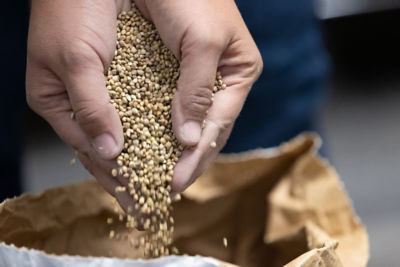Click here to download a PDF version of this spotlight.
» There has been a gradual shift in green bean production and marketing practices.
» Plant and bean characteristics are evolving to optimize quality and yield and to match consumer preferences.
» New packaging materials and methods can extend the shelf life of fresh market products.
FRESH MARKET BEANS
POD AND PLANT CHARACTERISTICS
The effort to develop bean varieties that best meet the preferences of buyers and consumers is a constant process for the vegetable seed industry. Currently, there is a preference for plants with upright canopies to help keep the pods off of the soil surface, reducing the incidence of pod infections by soilborne pathogens. Keeping the pods from touching the soil also results in straighter pods, as pods that touch the soil when they are developing are more likely to curve near the tip. Plants with an upright structure are also better adapted to machine harvesting, with less soil and plant debris contaminating the harvested pods.1
While home gardeners choose between Kentucky Wonder-type (flat-pod) varieties and Blue Lake-type (round-pod) varieties, most of the commercial bean varieties have rounded pods, and there is now a preference for pods with a dark-green color.
 Figure 1. Standard bulk, fresh market bean pods (left) compared to packaged, whole bean, pre-trimmed pods (right).
Figure 1. Standard bulk, fresh market bean pods (left) compared to packaged, whole bean, pre-trimmed pods (right).
There is also a preference for varieties that harvest with the peduncle (pod-stem) attached to the pod, as this helps prolong shelf life. In Europe, there has been an increase in demand for smaller (diameter and length) beans, and bean breeders have been expecting the U. S. market to follow that trend (Figure 1). Some growers in the U. S. are concerned that varieties with smaller pods do not yield as well, and they tend to prefer varieties with larger pods. However, many of the smaller pod varieties have yield levels similar to varieties with larger pods, as these plants often produce more pods per plant. Table 1 shows what sizes of pods are used for as various end products (fresh market and processing).

HARVEST
Beans need to be harvested on time to assure quality. The window for harvest can be as small as 36 hours to get the highest quality beans, as pods become fibrous when they are over-mature.1,2 Fresh market beans can be hand harvested or machine harvested. With hand harvesting, the crop can be harvested several times over a two-week period, harvesting only the beans of the desired size at any one harvest. With machine harvesting, all pods are harvested at the same time, resulting in a mix of pod sizes. Growers may get a premium price for hand-harvested beans. For fresh market bulk-bean displays, pods should be between 5 and 7 inches long, with most pods in the 5- to 6.5-inch range.1 However, there is a trend away from bulk-bean displays to bagged beans, and the pods may be snipped or not snipped. For non-snipped, bagged beans, it is desirable to have varieties that harvest with a high percentage of peduncles attached to the pods. Broken peduncles create wounds where decay can start.
PACKING AND STORAGE
Fresh market beans are packed in several different types and sizes of containers including the following:5
- 26- to 31-lb. bushel wire-bound crates/bushel hampers
- 25- to 30-lb. cartons/crates
- 20- to 22-lb. cartons
- 15-lb. cartons
- 12-oz. un-snipped or pre-snipped bags (retail)
- 10-lb. pre-snipped bags (foodservice)
Once packed, beans should be stored at temperatures between 41° and 45° F with relative humidity between 95 and 99%.3 This usually allows for a 7- to 10-day shelf life.2 Cartons should be stacked to allow good air circulation.5 Chilling injury can occur if beans are stored at temperatures below 40° F. Cold-injured beans may show surface pitting and russeting or other patterns of discoloration. Damage may not be visible until the beans are returned to warmer conditions, at which time rapid decay can occur.2,5 Beans are also very sensitive to ethylene and should not be stored with other products that generate ethylene.
New packing materials and methods are available that can increase the shelf life of beans. Modified atmosphere packaging (MAP) substitutes atmospheric air with a protective gas mixture to decrease the oxygen content and slow microbial growth. Some systems can adjust the level of oxygen in the package based on the respiration rate of the product. The use of bags made with breathable plastics can also reduce microbial growth, pod rot, and weight loss. These methods can extend the shelf life by 1 to 2 days.
MARKETING
Successful marketing of a bean crop requires planning and attention to matters of production, harvesting, packaging, transportation, distribution, warehousing, pricing, compliance with health and safety regulations, and being responsive to the demands of the consumer. There are many marketing opportunities for fresh market beans including direct marketing at roadside stands or farmers’ markets, sales to local grocery stores and specialty food stores, sales through cooperatives, and contracts with wholesale shippers.3,4
Working with a cooperative typically involves shared costs for packaging and shipping and pooled pricing of the product. When working with local retailers (grocery stores), growers must contact the produce managers and provide a high-quality product when the stores need them. When selling direct at roadside stands and farmers markets, growers can get a higher price for their product, as compared to the wholesale price, but there may be added advertising, labor, and facility expenses.4 With “pick-your-own” operations, labor costs are lower, but the total amount of product harvested and sold per acre is usually also lower.
PROCESSING BEANS
Growing beans for the processing market usually involves setting up a contract with a processor.4 The processor typically designates the bean varieties to be grown, along with instructions for planting and production methods. Harvest is typically done by the processing company or custom harvesters they have contracted.
For processing beans, there is also a strong preference for plants with upright canopies. However, unlike with fresh market beans, the processing market generally prefers pods with a bright-green color. Processors also prefer pods that detach from the peduncle at harvest. There has been an increase in packing canned or frozen whole-bean products that use smaller pod sizes. The processor may obtain enough small-sieve size beans by size grading them out from loads with mixed sizes. In other cases, the processor may contract for varieties that produce smaller sieve-size pods at maturity.
SOURCES
1 Maynard, L., Groff, M., Foster, R., and Egel, D. What a certified crop advisor should know about green beans. Purdue University.
2 Aguiar, J., Laemmlen, F., Baameur, A., and Mayberry, K. Snap bean production in California. University of California, Vegetable Research and Information Center. Publication 7240.
3 Hawkins, G., Sparks, A., Li, C., MacLean, D., Langston, D., Harrison, K., Sumner, P., Hurst, W., Boyhan, G., Culpepper, S., and Fonsah, E. 2013. Commercial snap bean production in Georgia. UGA Extension, Bulletin 1369.
4 Orzolek, M., Greaser, G., and Harper, J. 2017. Snap bean production. Penn State Extension.
5 Produce Market Guide. Commodity beans. https://www.producemarketguide.com/produce/beans. Websites verified 12/19/17.
ADDITIONAL INFORMATION
For additional agronomic information, please contact your local seed representative. Developed in partnership with Technology Development & Agronomy by Monsanto.
Individual results may vary, and performance may vary from location to location and from year to year. The information provided in this article may not be an indicator of results you may obtain as local growing, soil and weather conditions may vary. Growers should evaluate data from multiple locations and years whenever possible. The recommendations in this article are based upon information obtained from the cited sources and should be used as a quick reference for information about growing beans. The content of this article should not be substituted for the professional opinion of a producer, grower, agronomist, and similar professional dealing with this specific crop.
SEMINIS DOES NOT WARRANT THE ACCURACY OF ANY INFORMATION OR TECHNICAL ADVICE PROVIDED HEREIN AND DISCLAIMS ALL LIABILITY FOR ANY CLAIM INVOLVING SUCH INFORMATION OR ADVICE. 170826145842 010318DME
Seminis® is a registered trademark of Seminis Vegetable Seeds, Inc. All other trademarks are property of their respective owners. © 2018 Seminis Vegetable Seeds, Inc. All rights reserved.




